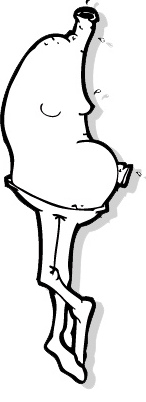colloidal food: monja-yaki
Tuesday, 9 September 2008 by nalika
I am not sure if Maytel is ready for this.

A colloidal and humble sibling of okonomiyaki is called monja-yaki.
While okonomiyaki is more of Osaka-origin (western Japan) and has a Hiroshima (southwestern Japan) variant, monja-yaki is of downtown Tokyo (eastern Japan)-origin.
Similar ingredients (shredded cabbage, flour, dashi broth, plus some extra meat, seafood, veggies etc.), but more watery.

Due to its high water content, it never solidifies.
You first fry the cabbage on the griddle, then make a cabbage circle weir, then pour the watery flour-mix ingredients in the middle. The batter is so watery that without the cabbage weir, it won't stay on the griddle.
When it's cooked it has a consistency of slime.

When done, you eat it with the special small metal scraper, directly from the griddle.

I know what you might be thinking.
It pretty much looks like puke.
As a matter of fact, the very first time I ate monja-yaki when I was a kid, I puked later in the evening, and thought it's not that different.
Okonomiyaki and monja-yaki, those flour batter food originates back in the postwar days in Japan. Having been bombed throughout the country, the rice was scarse, so people made something with flour that came in the aid package, mostly from the U.S.
Speaking of monja-yaki, there has not been much ingredient other than flour, water and a bit of chopped cabbage and seasonings.
Small candy shops would have a small griddle out on the street, and kids would come holding their wee pennies. They'd play with the batter by drawing letters on the griddle, thus the name monja-yaki (coming from moji=letter and yaki=fry).
Today it has become a lot more lux, some monja-yaki restaurants even throw in Norwegian salmon.
Tsukishima is famous for having their shopping arcade filled with fifty or more of these monja-yaki restaurants that it's often referred to as "monja street."
There may be some competitions, but when one place is full, impatient customers would go to another two doors down, so all in all it's not that ferocious. The problem is, once you are done with monja-yaki and want to move onto something else, you are surrounded by fifty other restaurants that serve the same thing.
The monja-yaki restaurants close somewhat early, most of them closing well before 10pm.
Another downtown monja-yaki enclave is found in tourist-friendly Asakusa, but unlike the monja street in Tsukishima, the restaurants there are more scattered.

A colloidal and humble sibling of okonomiyaki is called monja-yaki.
While okonomiyaki is more of Osaka-origin (western Japan) and has a Hiroshima (southwestern Japan) variant, monja-yaki is of downtown Tokyo (eastern Japan)-origin.
Similar ingredients (shredded cabbage, flour, dashi broth, plus some extra meat, seafood, veggies etc.), but more watery.

Due to its high water content, it never solidifies.
You first fry the cabbage on the griddle, then make a cabbage circle weir, then pour the watery flour-mix ingredients in the middle. The batter is so watery that without the cabbage weir, it won't stay on the griddle.
When it's cooked it has a consistency of slime.

When done, you eat it with the special small metal scraper, directly from the griddle.

I know what you might be thinking.
It pretty much looks like puke.
As a matter of fact, the very first time I ate monja-yaki when I was a kid, I puked later in the evening, and thought it's not that different.
Okonomiyaki and monja-yaki, those flour batter food originates back in the postwar days in Japan. Having been bombed throughout the country, the rice was scarse, so people made something with flour that came in the aid package, mostly from the U.S.
Speaking of monja-yaki, there has not been much ingredient other than flour, water and a bit of chopped cabbage and seasonings.
Small candy shops would have a small griddle out on the street, and kids would come holding their wee pennies. They'd play with the batter by drawing letters on the griddle, thus the name monja-yaki (coming from moji=letter and yaki=fry).
Today it has become a lot more lux, some monja-yaki restaurants even throw in Norwegian salmon.
Tsukishima is famous for having their shopping arcade filled with fifty or more of these monja-yaki restaurants that it's often referred to as "monja street."
There may be some competitions, but when one place is full, impatient customers would go to another two doors down, so all in all it's not that ferocious. The problem is, once you are done with monja-yaki and want to move onto something else, you are surrounded by fifty other restaurants that serve the same thing.
The monja-yaki restaurants close somewhat early, most of them closing well before 10pm.
Another downtown monja-yaki enclave is found in tourist-friendly Asakusa, but unlike the monja street in Tsukishima, the restaurants there are more scattered.

it really does look like puke
There really aren't many slimy foods that you eat communally. It's not like you share an oyster with a friend.
As a coincidence, I just came across this article when I was looking for stuff on neophilia (http://www.ncbi.nlm.nih.gov/pubmed/16298456) that more people find slimy food more disgusting than that which reminds them of animal origins.
slimy communal food... hmmm, how about a bowl of natto and okura passed along at the table? addition of cut-up squid sashimi makes it even better, if not quail york.
heheh. raw octopus w wasabi...
and all these kind of sea creature guts dishes.
or anything that's topped with that sticky Yamaimo mountain yam paste...
yeah maybe this is a Japanese thing? :-)
http://www.flickr.com/photos/kyleroth/2204458701/
I love slimy okra!
aaah, I so much miss maguro-yamakake.
well, Hawaiian poi is quite slimy and possibly communal too. any similar aboriginal slimy communal food in nz?
if you think of desserts, the world of slimy communal food expands... rice pudding, custard, molasses pie, tapioca pudding etc.